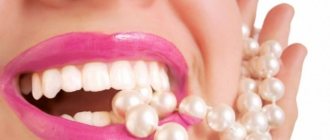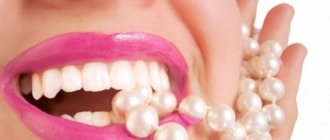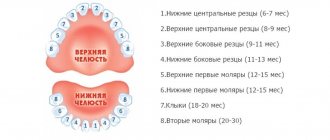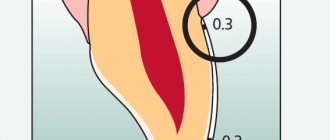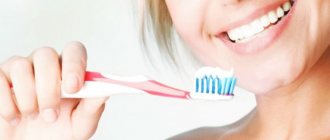Can't boast a Hollywood smile? Don't like the color of your tooth enamel? Did a tooth break and ruin your smile? There is an exit! These problems can be solved by artistic dental restoration. This is simply a magical procedure! You can restore the previous shape and color of one or several teeth at once in just one visit to the dentist.
Teeth are restored using two technologies. The first method is indirect, when ceramic plates are used to restore teeth. They are made by dental technicians in the laboratory.
The second method is direct. According to it, tooth extension occurs directly in the patient’s oral cavity. For this purpose, composite or adhesive materials are used.
Teeth renewed in this way (or regrown) are practically no different from real ones: they are just as strong, beautiful, natural and durable. However, they acquire all these qualities only if the restoration was carried out in compliance with all the necessary technological requirements inherent in a particular technique.
The cost of the procedure is pleasantly surprising, especially if you take into account its result: beautiful teeth without chips or cracks. In addition, restoration can also eliminate defects such as diastema and incorrect tooth length.
Types of professional teeth whitening
Reviews about types of teeth whitening on the Internet make many patients believe in the myth about the effectiveness of hydrogen peroxide purchased at the pharmacy, soda, activated carbon and other simple methods. Following such dubious advice is not only pointless, but also fraught with dangerous consequences - burns of the oral cavity, damage to the enamel and increased sensitivity of the teeth. In fact, there are only two types of professional whitening – in-office and at-home.
Is it possible to whiten artificial teeth?
Often patients who have ceramic or plastic dentures are interested in what will happen to them after the whitening procedure and is it possible to change their color? Unfortunately, metal-ceramic and other artificial teeth cannot be lightened using conventional methods, since hydrogen peroxide only affects organic compounds. Therefore, dentists recommend carrying out whitening procedures before dentures. Otherwise, such designs will require replacement with the selection of a new shade.
Extensions or teeth with fillings should not be bleached because they are also not exposed to bleach. If the patient decides to lighten the teeth, then he is advised to install new fillings, especially if they are located on the visible part of the dentition.
In-office bleaching
This term in dentistry means teeth whitening under the supervision of a doctor using gels based on hydrogen peroxide or urea, as well as catalysts in the form of ultraviolet light or a laser beam. The chemical composition affects only 20% of the organic substances contained in hard dental tissue (dentine) and does not cause any harm to the teeth. The final result of the procedure depends on the initial shade of the teeth, determined according to the VITA scale. In most cases, it is possible to achieve a lightening of 5 to 10 tones. Let's look at the features of each type of teeth whitening in the clinic.
Photobleaching
During photo-whitening, the whitening gel is applied to the tooth surface from the front. The action of the product is accelerated by a lamp with ultraviolet radiation. One session lasts 15 – 30 minutes. The maximum change in tooth shade is possible by 8 – 10 tones. The cost of the service is about 10,000 rubles.
Laser whitening
The reagent on the teeth is catalyzed by a laser beam rather than an ultraviolet lamp. Each tooth is processed separately. In one laser whitening procedure, you can improve your color by 12 shades. The price of an effective technique is proportionally high - from 20,000 rubles per session.
Chemical bleaching
In chemical whitening, a whitening gel is applied to the surface of the teeth, and no ultraviolet light or laser is used. The method is gentle, so teeth become whiter by only 5 to 7 tones. The cost of the procedure is about 12,000 rubles.
In-canal whitening
It is used when the tooth has darkened due to filling the canals with coloring materials. The dentist drills a hole in the tooth cavity, applies a brightening agent and places a temporary filling. After achieving the desired result, the final restoration of the tooth is carried out. Endo-whitening costs approximately 1,000 rubles per tooth.
Contrary to what many patients believe, the popular Air Flow procedure involves mechanical cleaning and not teeth whitening. A powerful stream of air, water, soda and other components removes bacterial and hard plaque, polishing and leveling the tooth surface. After the session, the teeth visually become whiter because they have been cleaned of impurities and returned to their natural color. The same can be said about ultrasonic whitening.
How are teeth whitened in dentistry?
To whiten teeth in the dentist’s office, only the most modern, effective and safe techniques are used.
Almost all technologies are based on the brightening effect of reactive oxygen species released during the activation of gels based on high concentrations of hydrogen peroxide. The entire whitening process takes place under the radiation of special lamps: halogen (Beyond Polus), LED (Luma Cool) or ultraviolet (Zoom 3).
The main advantages of office methods:
- Speed of the procedure. Whitening takes no more than an hour.
- High degree of efficiency. In one session it is possible to lighten enamel up to 12 shades.
- A snow-white smile lasts up to 5-7 years with proper dental care.
- The safety of the procedure, the progress of which is constantly monitored by a doctor.
Possible inconveniences that the patient may encounter during and after whitening:
- You need to stay in the dentist's chair in one position for about an hour.
- The risk of developing increased sensitivity of tooth enamel.
- You should not drink coffee, strong tea or red wine for several days. If the patient smokes, then it is necessary to minimize the number of cigarettes or completely abandon this bad habit.
- Dentures and fillings are not subject to bleaching, so it may be necessary to replace them with others that are more consistent with the new shade.
A new word in professional whitening is laser technology. It causes minimal discomfort to the patient, since during the procedure there is no heating of dental tissues and there is no risk of burns to the mucous membranes and skin. In addition, laser radiation noticeably compacts the enamel, thereby preventing its destruction by peroxide compounds. The only drawback of the method is its high cost.
«
Home whitening
The method is suitable for those who want to whiten their teeth without risk to health and save a lot of money. However, before using whitening at home, it is recommended to consult a dentist to avoid mistakes when choosing the appropriate product and in the process of using it.
Home whitening systems with trays
Gel with individual trays for home whitening is issued in dentists after consultation with a doctor. Simpler sets with standard mouth guards can be purchased at the pharmacy. Due to the low concentration of hydrogen peroxide or urea in the gel, teeth are lightened by 5 to 8 tones. The price of the set varies from 2,000 to 7,000 rubles. The cost of making an individual mouthguard will be about 6,000 rubles.
Stripes
The devices contain a gel with a small content of hydrogen peroxide. The strips are applied to the teeth for about 30 minutes for a month. The effect is lightening by 3 – 5 tones. The cost of the kit is from 1,000 to 4,000 rubles. Perhaps the most effective means of this type will be Crest strips.
Gels and varnishes
The teeth are coated with a whitening agent with remineralizing components using a brush or brush. As a rule, the solution does not require rinsing and is used regularly for two weeks. Teeth become 1–2 shades whiter. Purchase costs will range from 300 to 1,000 rubles. One example of such products is the Blanx whitening pencil.
Whitening pastes
Toothpastes, rinses, brushes and flosses with a whitening effect in rare cases “increase” whiteness by a maximum of 1 tone. Experts recommend using such products to maintain the results of professional whitening. The simplest whitening paste can be bought at an affordable price - from 150 rubles. Low-abrasion toothpaste with a brightening effect, Extreme Whitening Swissdent, will cost more.
Is it possible to whiten teeth using folk remedies?
Despite all the advances in medicine, recipes for folk remedies are still popular.
- Hydrogen peroxide is an available substance sold in every pharmacy. In order to whiten teeth with its help, it is necessary to treat the enamel surface with a 3% solution after hygienic cleaning. This must be done with extreme caution, since contact of active peroxide on the gums and mucous membranes can cause burns. It is not recommended to use this method for a long time or too often, since the organic matrix of the tooth may be destroyed along with the coloring pigments.
- Baking soda is also often used for whitening. With a toothbrush moistened with a strong soda solution, simply brush your teeth as usual. You can supplement this remedy with ordinary or sea salt. The procedure cannot be repeated more than once every 7-10 days.
- Tea tree oil is also present in folk recipes. Apply a few drops of natural oil to a toothbrush and massage your teeth with it for several minutes. The manipulation is carried out after evening hygienic cleaning before bedtime. This method is well suited for maintaining the white shade of enamel. As a preventative measure, the procedure is carried out 1-2 times a week.
Whether the use of such techniques is effective is a controversial issue. Dentists are extremely skeptical about them and do not recommend getting carried away with folk remedies.
«
Pros and cons of types of teeth whitening
Photobleaching
- Instant results.
- Uniform impact.
- The duration of the session is no more than an hour.
- Whitening by 8 – 10 tones.
- The occurrence of tooth sensitivity during and after the procedure.
Laser whitening
- Instant results.
- No discomfort during the procedure.
- Maintaining the acid balance of the oral cavity.
- Strengthening enamel.
- Whitening by 12 tones.
- The duration of the session is more than an hour.
- Uneven teeth whitening.
- High price.
Chemical bleaching
- Instant results.
- Uniform impact.
- Acceptable price.
- Simplicity of the procedure.
- Whitening by 5 – 7 tones.
- The occurrence of tooth sensitivity during and after the procedure.
- The need for several sessions.
In-canal whitening
- Local effect on tissue.
- Painless.
- Whitening by 5 – 7 tones.
- Weakening of dental tissues.
- Prohibition on repeating the procedure.
Whitening on trays
- Affordable price.
- Possibility to use the mouth guard at any time.
- Whitening by 5 – 8 tones.
- The duration of the course is 1 month.
Lightening strips
- Visible effect after the third application.
- Affordable price.
- Whitening by 3 – 5 tones.
- Inconvenient to use.
- The duration of the course is 1 month.
Varnish or pencil
- Ease of use.
- Minimum costs.
- Lightening by 1 - 2 tones.
- Poor efficiency.
What is the best way to save a pulpless “dead” tooth?
There is a special intracanal technology for whitening pulpless teeth. During internal whitening, a peroxide solution is injected into the tooth cavity, after which a temporary filling is applied. When you visit the dentist again, it is determined how well the new shade matches the color of the remaining teeth. If the result is satisfactory, the remaining solution is washed away and a permanent filling is placed.
Another possible method is external whitening by applying the gel to only one single tooth. In this case, you can also use home remedies.
What contributes to the darkening of crowns and dentures
It is not only the appearance of artistic restorations and fillings made using composite materials that causes dissatisfaction among patients in dental clinics. Some complain that they are not satisfied with the color of prosthetic structures made from metal-ceramics or plastic. Why is this happening?
Plastic products are similar in aesthetic and quality characteristics to those made from composites. The material is very “delicate”, it is porous, and quickly loses its aesthetics under the influence of food and drinks with dyes, from smoking, and due to lack of oral hygiene.
Metal-ceramic prostheses are a different story. And if you are going to install them in the smile area, which professional doctors strongly do not recommend doing, then you must have a clear understanding of their shortcomings:
- the metal shines through the ceramics: if the restoration is single, then this will be noticeable, especially in bright lighting,
- the metal oxidizes, so a bluish rim may appear at the border with the gum over time, which will further spoil the overall impression of your smile.
Important! In order not to think about the question of how to whiten artificial crowns and dentures installed in the smile area, initially choose the right materials from which they will be made. Ceramics and zirconium dioxide are ideal for the smile area: they do not change shade throughout their entire service life and have high aesthetics.
Wearing a night guard
Sometimes your doctor may prescribe a night guard. If you have bruxism (teeth grinding due to too much clenching of the jaw and involuntary contraction of the chewing muscles), then in order not to damage the restoration during sleep, you need a mouthguard. It is made individually for you and therefore you will not feel any inconvenience with it. But remember, a mouth guard is a dental protection, not a treatment for bruxism. Therefore, if you have such a problem, it requires a solution and contacting specialists.
We provide a guarantee for dental restoration. But it has been noted that if the patient strictly follows all our recommendations, then the restorations will safely serve for 7 years or more. Agree, such a smile is worth the effort!
What is the best way to whiten tetracycline teeth?
When taking some antibiotics from the tetracycline group, a person may change the color of tooth enamel. It becomes dirty yellow, brown or dark gray. This is especially noticeable when treated with such drugs in childhood during the formation of teeth.
Tetracycline teeth are extremely difficult to whiten because the pigmentation is deep. In this case, folk remedies and home methods will not be effective. Only professional whitening techniques in a dental office can help. Often several procedures are required in succession.
Whitening toothpastes
Whitening toothpastes contain abrasive microparticles. It is under their influence that coloring substances are removed from the surface of the enamel. At the same time, these particles cannot cause mechanical damage to the enamel itself, since the enamel is many times stronger than these particles. However, such pastes can only be used if there are no fixed dentures in the oral cavity.
Rough particles can create micro-scratches on the surface of dentures. Over time, bacteria accumulate in these scratches invisible to the eye, and then tartar forms. As a result, instead of whitening the dentures, the reverse process occurs.
We strongly recommend that people with fixed dentures use only regular toothpaste, not whitening toothpaste.
Precautionary measures
Even vitamins and minerals can be harmful if taken in excess or used in the wrong way.
So you need to take precautions with teeth whitening products:
- Firstly, remember about possible individual intolerance , monitor the body’s reaction and stop taking it if even mild signs of allergy occur.
- Secondly, solutions (including soda solution) cannot be used too often . In pursuit of the fastest and most powerful effect, you can irritate the mucous membranes or increase tooth sensitivity.
- And thirdly, vegetables, fruits and nuts must be fresh and not heat-treated . Fried onions or baked apples will seem tastier to many than raw ones, but, unfortunately, they will lose a significant part of their beneficial properties.
Negative consequences after chemical whitening of tooth enamel
Everything that was said above applies to the chemical method of teeth whitening. It should be understood that in this case, tooth enamel is exposed to an aggressive substance, and this can lead to negative consequences.
One of them is demineralization of tooth enamel. The whitening solution not only washes away the dyes from the surface of the teeth, but also washes away the beneficial minerals contained in it. This increases the sensitivity of teeth to cold and heat. Even worse, excessively frequent chemical bleaching causes the enamel to become brittle. Microcracks may even appear in it.
The second threat from the chemical method is the possibility of loss of enamel shine. If trays or gel are used incorrectly, the enamel may become matte, that is, not a natural color.
How do stars whiten their teeth?
Celebrities spend many tens of thousands of dollars on their snow-white smiles. After all, the overall appearance and potential success depend on them. Therefore, such people do not skimp on the dentist and do not use questionable techniques. To achieve radiant whiteness, stars trust only modern professional techniques: Zoom 3, Luma Cool, laser whitening. But they are not limited to the lightening procedure. To maintain the achieved shade, periodic professional cleaning of the enamel is carried out, and special proven toothpastes are used for everyday care.
In order for your smile to be as radiant as that of the stars, you should not experiment with whitening agents. It is better to contact a good specialist who will assess the condition of the oral cavity and give a personal recommendation as to which remedy will be optimal for your particular situation. When carrying out the procedure at home, you must strictly follow the instructions and not violate the whitening technology. Only in this case can you count on success without negative health consequences.
How to whiten teeth under braces?
Improper care and drinking coffee or strong tea in large quantities lead to the fact that teeth in braces acquire an unsightly yellowish tint. But in such cases, enamel whitening cannot be carried out until the orthodontic bracket system is removed. Lightening gels do not penetrate under the structural elements and as a result, dark spots form on the surface of the teeth. In addition, people who wear braces have teeth that are more susceptible to decay. Therefore, you should wait a bit with the whitening procedure.
The only option in such situations is to regularly visit the hygienist's office for professional cleaning. This procedure will not change the natural shade of the teeth, but will get rid of the unsightly yellow plaque and give your smile a natural beauty.
Nutrition after tooth restoration
In the first few hours after restoration, the dentist does not recommend eating solid food and avoid chewing with the restored tooth in the first days. Subsequently, loading the tooth is also not recommended, since the extended tooth does not have the same strength as a natural one.
It is also recommended to follow the following rules:
- Do not eat food that may change the color of the restored area. These are products such as coffee, berries and fruits with bright colors, some sauces and seasonings.
- Hard vegetables and fruits must be cut into small pieces. You should especially avoid biting off pieces when restoring anterior teeth.
- Avoid cracking nuts and seeds with your teeth.
- Do not eat food that is too hot or cold.
Only the dentist who performed the procedure can answer the exact question of how much you should not eat after restoration. The period depends on the complexity of the restoration operation. For example, when using pins you will have to stop eating for a day.
In addition, restrictions on food intake are imposed when using painkillers until their effect completely subsides.
Reasons for discoloration of extended teeth
The situation when the extended tooth turns yellow several years after a visit to the dentist is quite normal. Most often this is due to the quality of the materials with which the doctor performed the extension. As a rule, these are composites. They tend to accumulate odors and dyes. In addition, if they are not polished every 3-4 months, they lose their smoothness, become rough and “cling” to plaque even better, and also absorb various pigments.
Important! The extended tooth requires very careful hygienic care and also requires adherence to a certain diet, which is especially important when the restoration is performed in the frontal area of the smile. Otherwise, after a short period of time you may notice that it is different in color from the rest.
A bad habit such as smoking can cause a quick change in the shade of the restoration.
Darkening can also be caused by other serious circumstances: trauma, development of secondary caries, pulp necrosis, incorrectly or poorly treated root canals. However, then, in addition to the change in shade, you will probably be bothered by other unpleasant symptoms, for example, pain. And here the first goal will not be bleaching, but treatment. To do this, you need to seek professional help as quickly as possible.
If before the extension the doctor removed the nerve and treated the canals, then the darkening of the enamel is associated precisely with depulpation, because the tooth was deprived of its source of vital nutrition, it became “dead,” fragile and susceptible to any negative factor from the outside. A tooth can also darken from the inside due to filling the canals with resorcinol-formalin paste.
The reason that the cured one stands out in color from the rest may also be the method of its restoration. For example, if the extension was carried out on a metal pin, then the rod may be visible through the restoration materials.

